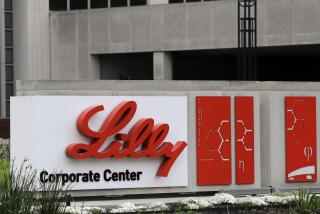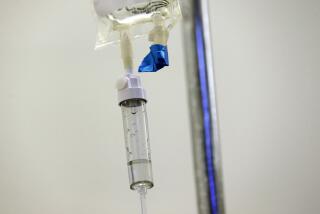Demand for Drug to Treat Bird Flu Surges
- Share via
Tamiflu, the chief antiviral drug used to treat bird flu, has been flying off the shelves as doctors and hospitals stock up for a possible pandemic.
U.S. pharmacies saw a sevenfold increase in Tamiflu prescriptions since mid-August -- about 87,000, compared with fewer than 13,000 last year -- according to a survey by Yardley, Pa.-based research firm Verispan.
Roche Pharmaceuticals, the Switzerland-based manufacturer of Tamiflu, said it could meet normal flu-season demand nationwide and was gradually filling massive bulk orders from national governments building strategic stockpiles.
But some pharmacy executives already are worrying about supply problems.
“Distributors get it in Monday and it’s gone by Tuesday,” said Robert Drucker, chief executive of RxUSA, a large online drugstore based in Port Washington, N.Y. “Whatever is available will be gobbled up quickly. Governments are buying up the market.”
He said the situation resembled the fear-driven surge in demand for Cipro, a recommended antibiotic for anthrax, after the 2001 terrorist mailings.
Flu fears have apparently prompted many doctors to order Tamiflu while they know they can get it. A doctor in Texas recently bought $35,000 worth of flu drugs from RxUSA -- largely Tamiflu.
“Most of this is about bird flu -- mental bird flu,” Drucker said.
Jan Drugs, an online pharmacy based in Canada, is filling 40 to 50 Tamiflu prescriptions a week, up from about five to 10 orders a few weeks ago, and faces three- to four-day delays from its distributor.
“It tends to be physicians who seem to be getting it for themselves or their families,” said Len Hillary, a Jan Drugs pharmacist. “A lot of them figure $50 or $60 is money well spent” as a personal insurance policy.
Rite Aid Corp., a large national pharmacy chain, has an ample supply of the drug but has seen orders surge to levels normally seen in December or January, near the peak of the annual flu season, spokeswoman Jody Cook said.
Bird flu has killed 60 people in Asia since December 2003, according to the World Health Organization. Nearly all of the victims contracted the disease from sick or dead birds.
Health officials have warned that if the virus mutates into a form easily passed between people, it could spark a global pandemic that could kill tens of millions of people.
Tamiflu was introduced in 1999 to treat patients with the common flu. Demand was relatively modest until it was identified as one of the only drugs effective against the bird flu.
Despite the surge in orders, retail prices for Tamiflu have held steady, according to PharmacyChecker.com, an Internet search service for prescription drug sales. On Wednesday, a standard course of 10 pills was selling for $49 to $75.
Roche faces pressure to increase production capacity from the United Nations and 40 national governments that have placed orders with the company. But demand is expected to outstrip supply for the foreseeable future, partly because the drug takes about a year to produce.
“We doubled capacity in 2004, we are going to double it again in 2005 and we will further increase manufacturing capacity in 2006,” in part through collaboration with other manufacturers, said Terence Hurley, a Roche spokesman.
The first U.S. Tamiflu plant will open this year.
Sales of the drug for the first six months of 2005 were 580 million Swiss francs ($452 million), and the company projects sales of 350 million francs ($271 million) to governments for stockpiles by the end of the year, on top of normal flu season sales, Hurley said. This compares with overall sales of 330 million francs for all of 2004.
Roche shares, traded in Switzerland, have been hot this year and are up 43% year to date. By contrast, an index of 13 major U.S. drug shares is down 6.2% year to date.
Relenza, the only other drug recommended for bird flu, is also in short supply, said Patty Seif, a spokeswoman for its manufacturer, GlaxoSmithKline.
Global sales of Relenza were $5.5 million last year. That figure is expected to rise sharply as the company fills bulk orders from governments that will exhaust most production capacity.
“We are doing everything we can to ramp up production,” Seif said. “But if demand becomes excessive we won’t be able to meet it.”
*
Times staff writer Tom Petruno contributed to this report.
More to Read
Sign up for Essential California
The most important California stories and recommendations in your inbox every morning.
You may occasionally receive promotional content from the Los Angeles Times.










